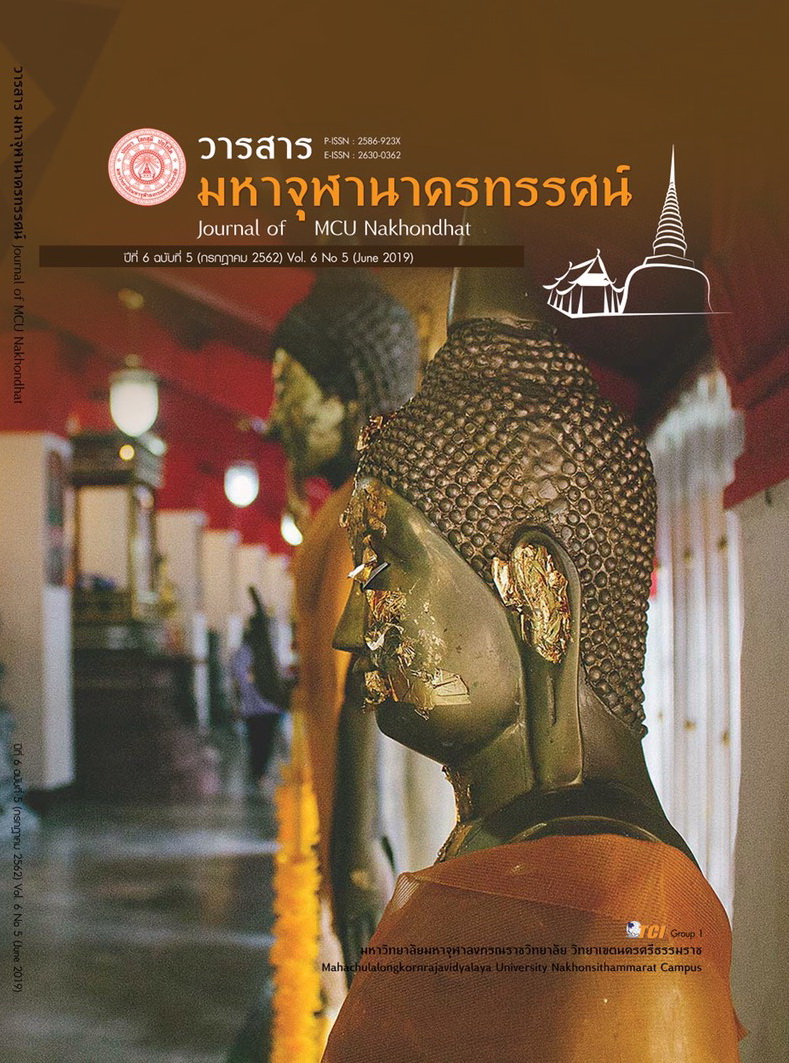AN ANALYTICAL STUDY OF THE USAGE OF WORD ANATTA IN THERAVADA BUDDHISM THROUGH THE VIEW OF BUDDHADASA BIKKHU
Main Article Content
Abstract
The study entitled “An Analytical Study of Anattatā in Theravada Buddhism through Buddhadasa Bhikkhu’s View” aimed to explore Anattatā according to Buddhadasa bhikkhu’s view, and to analyze Anattatā in Theravada Buddhism through Buddhadasa bhikkhu’s view. Qualitative research on the concept of Atta in Theravada Buddhism focusing on documentary research was employed in order to apply in the current society and as the guideline for the propagation of Buddhism.
The findings of a research:
Findings indicated that the view on Atta proposed by Buddhadasa is mainly the same with Buddhist philosophy in the Tripitaka. Although his teaching mainly deals with Atta which leads some people misunderstand that Buddhadasa bhikkhu does not belong to Theravada Buddhism, his teaching on ‘I AND MINE’ or Atta is the way of teaching to realize the characteristics of Atta clearly that clinging is nothing but Atta ,which is the abstract that should be explained along with tangibility. Due to clinging, one cannot find the real happiness. When most people clearly understand Attà and Anattà, it is easy to separate Atta from Anatta. Buddhadàsa bhikkhu himself taught self and non-self as taught in Buddhist philosophy, by pointing out the characteristics of self and non-self, leading to non-self to find the peaceful happiness called ‘niràmisa-sukha’ which also can be found in the Buddhist Canon. However, teaching method and language used by Buddhadasa bhikkhu are different because of his simple teaching method and language. In communication, he used the simple language, such as I and MINE, which is very clear. His works are suitable and ideal for learners of every age. People can understand the real teaching of Buddhism without knowledge of Pali language.His teaching on Attà is to make people clearly understand Attà, using Atta to abandon Atta that is Upàdàna (attachment) should not be used in Attà because everything is Anattà. His teachings are similar to that of teachings as in the Buddhist Tripitaka.
Article Details
References
จำนงค์ ทองประเสริฐ. (2539). ปรัชญาประยุกต์ ชุดอินเดีย. กรุงเทพมหานคร: บริษัท ต้นอ้อ แกรมมี่ จำกัด.
พระมหาสมจินต์ สมฺมาปญฺโญ (วันจันทร์). (2544). พุทธปรัชญาสาระและพัฒนาการ. กรุงเทพมหานคร: โรงพิมพ์มหาจุฬาลงกรณราชวิทยาลัย.
วัชระ งามจิตรเจริญ. (2544). นิพพานในพุทธปรัชญาเถรวาท : อัตตาหรืออนัตตา. ใน วิทยานิพนธ์พุทธศาสตรมหาบัณฑิต สาขาวิชาปรัชญา. มหาวิทยาลัยมหาจุฬาลงกรณราชวิทยาลัย.
ศิริวรรณ โอสถานนท์. (2523). การวิจัยเชิงเปรียบเทียบทรรศนะเรื่องตัวตนในพุทธปรัชญากับ ปรัชญาของเดวิด ฮูม. ใน วิทยานิพนธ์อักษรศาสตรมหาบัณฑิต สาขาวิชาปรัชญา. มหาวิทยาลัยจุฬาลงกรณมหาวิทยาลัย.


